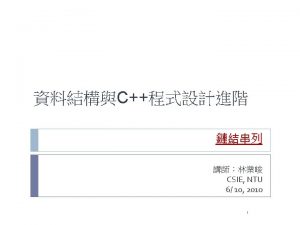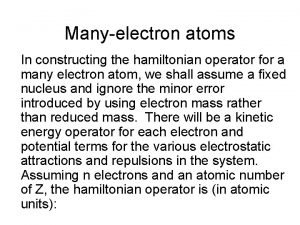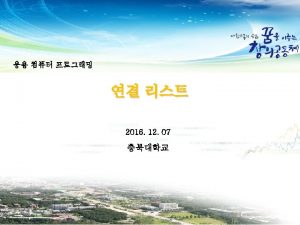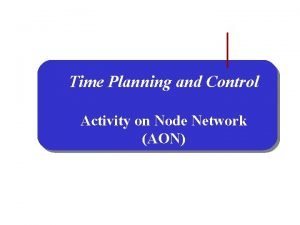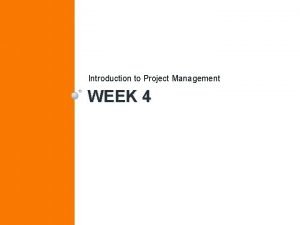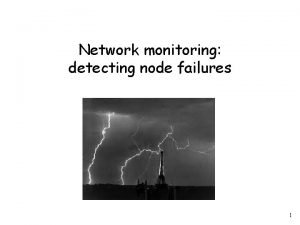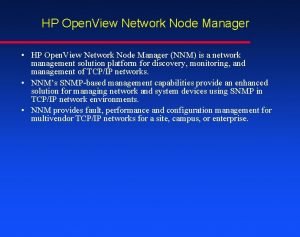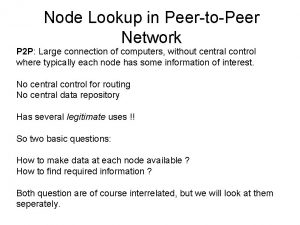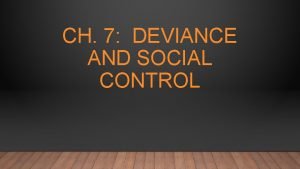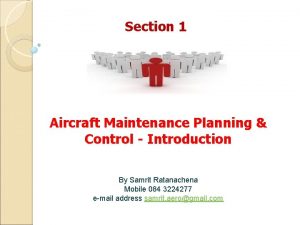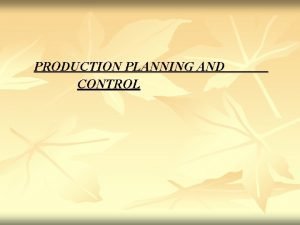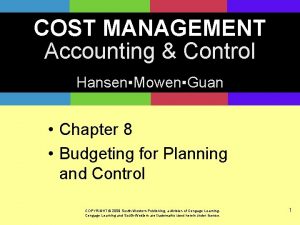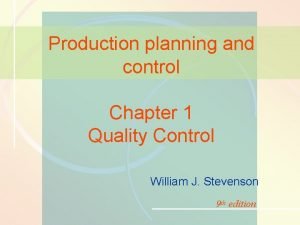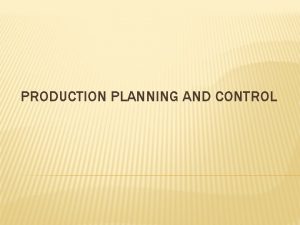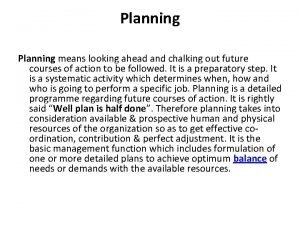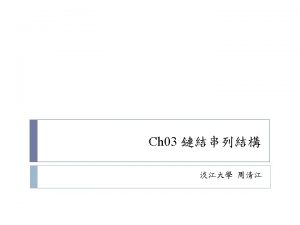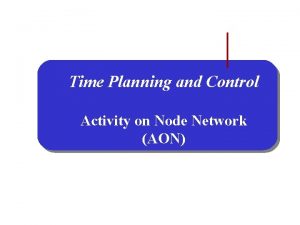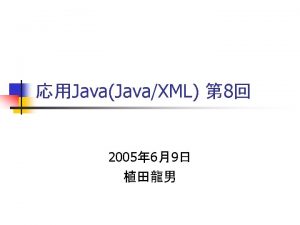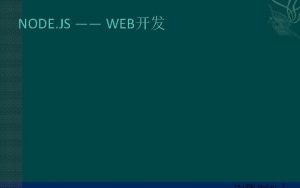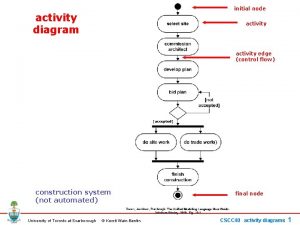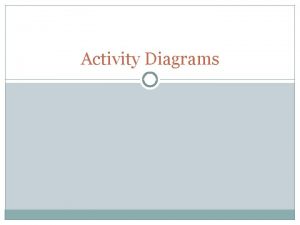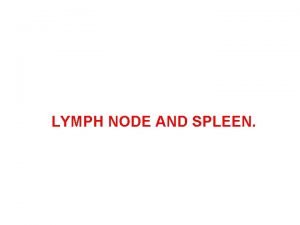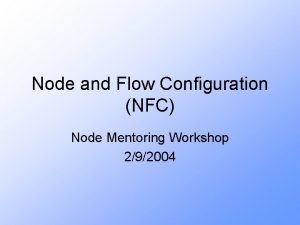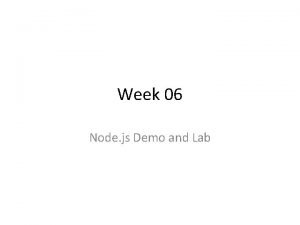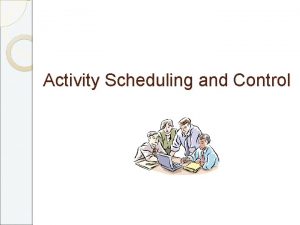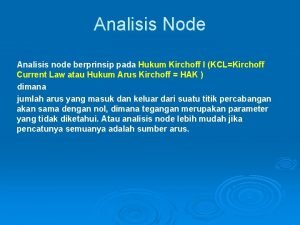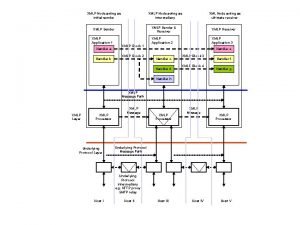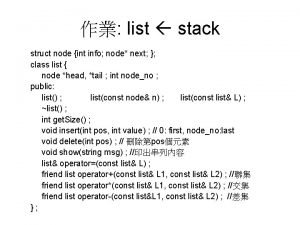Time Planning and Control Activity on Node Network

































- Slides: 33

Time Planning and Control Activity on Node Network (AON)

<Processes of Time Planning and Control Processes of Time Planning 1. Visualize and define the activities. 2. Sequence the activities (Job Logic). Logic 3. Estimate the activity duration. 4. Schedule the project or phase. 5. Allocate and balance resources. Processes of Time Control 1. Compare target, planned and actual dates and update as necessary. 2. Control the time schedule with respect to changes

Network Based Project Management þ Network Techniques Development: þ CPM by Du. Pont for chemical plants (1957) þ PERT by Booz, Allen & Hamilton with the U. S. Navy, for Polaris missile (1958) þ They consider precedence relationships and interdependencies þ Each uses a different estimate of activity times Developing the Network by: 1. Arrow diagramming (AOA) 2. Node diagramming (AON) 3. Precedence diagramming (APD) – 4. Time scaled Network (TSN)

<Activity on Node Notation ES D EF Activity ID FF LS LF TF ØEach time-consuming activity is portrayed by a rectangular figure ØThe dependencies between activities are indicated by dependency lines (arrows) going from one activity to another. ØEach activity duration in terms of working days is shown in the upper, central part of the activity box. ØThe principal advantage of the activity on node network is that it eliminates the need for dummies

ES <Activity Box Duration Earliest Starting Date ES LS Free Float ID FF Successor TF LF Total Float EF Activity ID FF LS LF TF Earliest Finishing Date EF Activity Predecessor Latest Starting Date D D Latest Finishing Date The left side of the activity box (node) is the start side, while the right side is the finish (end) side.

<Activity on Node Network ES D EF Activity ID FF LS LF TF ØEach activity in the network must be preceded either by the start of the project or by the completion of a previous activity. ØEach path through the network must be continuous with no gaps, discontinuities, or dangling activities. ØAll activities must have at least one activity following, except the activity that terminates the project. ØEach activity should have a unique numerical designation (activity code). Activity code is shown in the upper, central part of the activity box, with the numbering proceeding generally from project start to finish.

<Network Format ES D EF Activity ID FF LS LF TF ØA horizontal diagram format is the standard format. ØThe general developing of a network is from start to finish, from project beginning on the left to project completion on the right. ØThe sequential relationship of one activity to another is shown by the dependency lines between them. ØThe length of the lines between activities has no significance. ØArrowheads are not always shown on the dependency lines because of the obvious left to right flow of time. ØDependency lines that go backward from one activity to another (looping) looping should not be used. ØCrossovers occur when one dependency line must cross over another to satisfy job logic.

ES <Example D EF Activity ID FF LS LF TF The activity list shown below represents the activities, the job logic and the activities’ durations of a small project. Draw an activity on node network to represent the project. Activity Depends on A B C E F D S R D R, S B, C None A, C Duration (days) 4 5 8 7 3 4 2 9

<Example 4 2 A S Activity Depends Duration on (days) A D 4 B R 5 C D 8 E R, S 7 F B, C 3 D None 4 S A, C 2 R A, C 9 ES D Activity ID FF LS LF TF 4 7 0 D E END 8 9 5 3 C R B F EF

ES <Network Computations D EF Activity ID FF LS LF TF The purpose of network computations is to determine: ØThe overall project completion time; and ØThe time brackets within which each activity must be accomplished (Activity Times ). In activity on node network, all of the numbers associated with an activity are incorporated in the one node symbol for the activity, whereas the arrow symbols contain each activity’s data in the predecessor and successor nodes, as well as on the arrow itself or in a table. ES Duration EF Activity ID LS TF FF LF

<EARLY ACTIVITY TIMES ES D EF Activity ID FF LS LF TF 1. The "Early Start" (ES) or "Earliest Start" of an activity is the earliest time that the activity can possibly start allowing for the time required to complete the preceding activities. 2. The "Early Finish" (EF) or "Earliest Finish" of an activity is the earliest possible time that it can be completed and is determined by adding that activity's duration to its early start time.

<COMPUTATIONS OF EARLY ACTIVITY TIMES ES D EF Activity ID FF LS LF TF Ø Direction: Direction Proceed from project start to project finish, from left to right Ø Name: Name This process is called the "forward pass". pass Ø Assumption: Assumption every activity will start as early as possible. That is to say, each activity will start just as soon as the last of its predecessors is finished. Ø The ES value of each activity is determined first. Ø The EF time is obtained by adding the activity duration to the ES time. EF = ES + D Ø In case of merge activities the earliest possible start time is equal to the latest (or largest) largest of the EF values of the immediately preceding activities.

ES <Example D EF Activity ID FF LS LF TF Calculate the early activity times (ES and EF) and determine project time. 4 4 8 A 12 2 14 EF = ES + D S Largest EF 0 4 4 D 4 8 12 12 9 21 C R 21 7 28 29 0 29 E END 21 5 26 B 26 3 29 F

<LATE ACTIVITY TIMES ES D EF Activity ID FF LS LF TF 3. The “Late Finish" (LF) or "Latest Finish" of an activity is the very latest that it can finish and allow the entire project to be completed by a designated time or date. 4. The “Late Start” (LS) or "Latest Start" of an activity is the latest possible time that it can be started if the project target completion date is to be met and is obtained by subtracting the activity's duration from its latest finish time.

<COMPUTATIONS OF LATE ACTIVITY TIMES ES D EF Activity ID FF LS LF TF Ø Direction: Direction Proceed from project end to project start, from right to left Ø Name: Name This process is called the “backward pass". pass Ø Assumption: Assumption Each activity finishes as late as possible without delaying project completion. Ø The LF value of each activity is obtained first and is entered into the lower right portion of the activity box. Ø The LS is obtained by subtracting the activity duration from the LF value. LS = LF - D Ø In case of burst activities LF value is equal to the earliest (or smallest) smallest of the LS times of the activities following.

<EXAMPLE ES Calculate the late activity times (LS and LF). 4 4 8 0 4 Activity ID FF LS LF TF S 12 20 22 4 21 7 28 E 29 0 29 END 4 22 29 D 0 EF LS = LF - D 12 2 14 A 8 D 4 8 12 12 9 21 C R 4 12 12 21 29 21 5 26 B 26 3 29 21 26 26 F Smallest LS 29 29

<FLOAT Time ES D EF Activity ID FF LS LF TF Ø Float or leeway is a measure of the time available for a given activity above and beyond its estimated duration. Ø Two classifications of which are in general usage: Total Float and Free Float

<TOTAL FLOAT ES D Activity ID FF LS LF TF Ø The total float of an activity is obtained by subtracting its ES time from its LS time. Subtracting the EF from the LF gives the same result. Total float (TF) = LS - ES = LF - EF Ø An activity with zero total float has no spare time and is, therefore, one of the operations that controls project completion time. Ø Activities with zero total float are called "critical activities“. activities EF

<EXAMPLE ES D Activity ID EF FF LS TF LF Calculate Total Float for an activity. Total float (TF) = LS - ES = LF - EF 4 4 8 A 8 0 4 4 12 12 2 14 S 20 8 22 4 21 7 28 E 29 0 29 END 4 22 1 29 29 0 29 D 0 0 4 8 12 12 9 21 C 4 0 12 26 3 29 R 21 5 26 B 12 0 21 21 0 26 26 0 29 F

<CRITICAL PATH ES D EF Activity ID FF LS LF Ø Critical activity is quickly identified as one whose two start times at the left of the activity box are equal. Also equal are the two finish times at the right of the activity box. Ø The critical activities must form a continuous path from project beginning to project end, this chain of critical activities is called the "critical path". Ø The critical path is the longest path in the network. TF

<CRITICAL PATH ES D EF Activity ID FF LS LF Ø The critical path is normally indicated on the diagram in some distinctive way such as with colors, heavy lines, or double lines. Ø Any delay in the finish date of a critical activity, for whatever reason, automatically prolongs project completion by the same amount. TF

ES <CRITICAL PATH 4 4 8 A 8 0 4 4 12 0 FF LS LF TF S 20 8 22 4 21 7 28 E 29 0 29 END 4 22 1 29 29 0 29 4 8 12 12 9 21 C 4 0 12 26 3 29 R 21 5 26 B 12 0 21 21 0 26 26 0 29 F EF Activity ID 12 2 14 D 0 D

<FREE FLOAT ES D EF Activity ID FF LS LF TF Ø The free float of an activity is the amount of time by which the completion of that activity can be deferred without delaying the early start of the following activities. Ø The free float of an activity is found by subtracting its earliest finish time from the earliest start time of the activities directly following. Ø FF = The smallest of the ES value of those activities immediately following - EF of the activity. = the smallest of the earliest start time of the successor activities minus the earliest finish time of the activity in question. FFi = Min. (ESj) - EFi

<CALENDAR-DATE SCHEDULE ES D EF Activity ID FF LS LF TF ØActivity times (ES, EF, LS, LF) obtained from previous calculations are expressed in terms of expired working days ØFor purposes of project directing, monitoring and control, it is necessary to convert these times to calendar dates on which each activity is expected to start and finish. ØThis is done with the aid of a calendar on which the working days are numbered consecutively, starting with number 1 on the anticipated start date and skipping weekends and holidays.

<Advantages and disadvantages of network diagram Advantages Ø Show precedence well Ø Reveal interdependencies not shown in other techniques Ø Ability to calculate critical path Ø Ability to perform “what if” exercises Disadvantages Ø Default model assumes resources are unlimited Ø You need to incorporate this yourself (Resource Dependencies) when determining the “real” Critical Path Ø Difficult to follow on large projects

Example 2: Milwaukee Paper Manufacturing's Activity A B C D E F G H Description Build internal components Modify roof and floor Construct collection stack Pour concrete and install frame Build high-temperature burner Install pollution control system Install air pollution device Inspect and test Table 3. 2 (Frome Heizer/Render; Operation Management) Immediate Predecessors — — A A, B C C D, E F, G Time (weeks) 2 3 2 4 4 3 5 2

Activity Example 2: Milwaukee Paper Manufacturing's Description Build internal components — 2 B Modify roof and floor — 3 C Construct collection stack A 2 D Pour concrete and install frame A, B 4 E Build high-temperature burner C 4 F Install pollution control system C 3 G Install air pollution device D, E 5 H Inspect and test F, G 2 2 3 A C F 2 H 4 E 3 B 4 D Time (weeks) A 2 0 Start Immediate Predecessors 5 G

Activity Example 2: Milwaukee Paper Manufacturing's Description Immediate Predecessors Time (weeks) A Build internal components — 2 B Modify roof and floor — 3 C Construct collection stack A 2 D Pour concrete and install frame A, B 4 ES/EF calculation E Build high-temperature burner C 4 F Install pollution control system C 3 EF = ES + Activity time G Install air pollution device D, E 5 H Inspect and test F, G 2 0 2 2 2 4 4 3 7 C F A ES 0 0 2 0 13 2 15 4 4 8 Start E 0 3 B 3 3 4 D 7 H MAX(EF of Preceding activities 7, 8) 8 5 13 G

Activity Example 2: Milwaukee Paper Manufacturing's Description Immediate Predecessors Time (weeks) A Build internal components — 2 B Modify roof and floor — 3 C Construct collection stack A 2 D Pour concrete and install frame A, B 4 LS/LF calculation E Build high-temperature burner C 4 F Install pollution control system C 3 LS = LF - Activity time G Install air pollution device D, E 5 H Inspect and test F, G 2 0 2 2 4 4 3 7 C F A 2 0 0 4 LF = Min(LS of activities 4, 10) Start 0 2 0 10 0 3 3 3 B 1 7 13 2 15 4 4 8 H E 4 4 13 13 8 8 5 13 G D 4 4 8 15 8 13 LF = EF of Project

Example 2: Milwaukee Paper Manufacturing's Activity Total Float calculation Slack = LS – ES Slack = LF – EF 0 2 2 or 0 0 0 2 — 2 B Modify roof and floor — 3 C Construct collection stack A 2 D Pour concrete and install frame A, B 4 E Build high-temperature burner C 4 F Install pollution control system C 3 G Install air pollution device D, E 5 H Inspect and test F, G 2 C F 2 0 4 10 6 13 13 2 15 4 4 8 Start 0 0 Time (weeks) Build internal components 4 3 7 0 Immediate Predecessors A 2 2 4 A 0 Description H E 0 13 0 15 4 0 8 0 3 3 B 1 1 4 3 4 7 8 5 13 D G 4 1 8 8 0 13 LF = EF of Project

Example 2: Milwaukee Paper Manufacturing's Computing Slack Time (Float Time) Earliest Start Finish Activity ES EF A 0 2 B 0 3 C 2 4 D 3 7 E 4 8 F 4 7 G 8 13 H 13 15 Latest Start LS 0 1 2 4 4 10 8 13 Latest On Finish Slack Critical LF LS – ES Path 2 0 Yes 4 1 No 4 0 Yes 8 1 No 8 0 Yes 13 6 No 13 0 Yes 15 0 Yes

Example 2: Milwaukee Paper Manufacturing's Critical Path for Milwaukee Paper: A, C, E, G, H 0 0 Start 0 0 0 2 0 A 0 2 2 2 C 0 4 4 4 F 10 6 0 4 3 4 7 13 13 8 E 0 4 0 3 1 B 1 3 4 4 D 1 8 0 7 8 8 5 8 G 0 13 13 Activity Duration ES EF LS LF TF FF CP A 2 0 2 0 0 Y B 3 0 3 1 4 1 0 N C 2 2 4 0 0 Y D 4 3 7 4 8 1 1 N E 4 4 8 0 0 Y F 3 4 7 10 13 6 6 N G 5 8 13 0 0 Y H 2 13 15 0 0 Y 2 15 H 13 0 15

Example 2: Milwaukee Paper Manufacturing's ES –EF GANTT CHART SCHEDULE ACTIVITY A Build internal components C Construct collection stack E Build high-temperature burner 1 2 3 4 5 6 7 8 9 10 11 12 13 14 15 16 G Install air pollution device H Inspect and test B Modify roof and floor D Pour concrete and install frame F Install pollution control system LS –LF GANTT CHART SCHEDULE ACTIVITY A Build internal components C Construct collection stack E Build high-temperature burner G Install air pollution device H Inspect and test B Modify roof and floor D Pour concrete and install frame F Install pollution control system 1 2 3 4
 Aon and aoa network diagrams examples
Aon and aoa network diagrams examples Reference node and non reference node
Reference node and non reference node Reference node and non reference node
Reference node and non reference node Node and anti node
Node and anti node Typedef struct in c
Typedef struct in c Hamiltonian operator
Hamiltonian operator Struct node int data struct node* next
Struct node int data struct node* next Activity on node
Activity on node Activity on node
Activity on node Fork node activity diagram
Fork node activity diagram Node js network monitor
Node js network monitor Hp openview network node manager
Hp openview network node manager Node lookup in peer to peer network
Node lookup in peer to peer network Elapsed time
Elapsed time Activity and activity coefficient
Activity and activity coefficient Social control examples
Social control examples Proactive planning and reactive planning
Proactive planning and reactive planning Long medium and short term planning in primary schools
Long medium and short term planning in primary schools Language planning slideshare
Language planning slideshare Virtual circuit and datagram networks
Virtual circuit and datagram networks Features of peer to peer network and client server network
Features of peer to peer network and client server network Network centric computing
Network centric computing Activity 2 limiting reactants activity
Activity 2 limiting reactants activity Form content and use
Form content and use Activity 1 activity 2
Activity 1 activity 2 3
3 Activity 1 activity 2
Activity 1 activity 2 Aircraft maintenance planning
Aircraft maintenance planning Production schedule meaning
Production schedule meaning Budget planning and control
Budget planning and control Manufacturing planning and control
Manufacturing planning and control Production planning and quality control
Production planning and quality control Difference between route card and route sheet
Difference between route card and route sheet Planning is looking ahead
Planning is looking ahead




